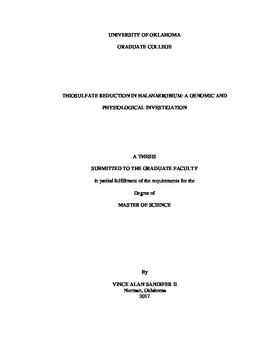| dc.description.abstract | Bacteria that produce sulfide have been investigated for their role in corrosion of steel surfaces. Attention has mainly focused on bacteria able to reduce sulfate to sulfide (SRB). However, bacteria that produce sulfide by reducing thiosulfate (TRB) but can’t reduce sulfate, have recently become of interest for their role in causing corrosion. Current molecular detection methods fail to detect these TRB, which may use a different pathway than SRB for thiosulfate and sulfite reduction. This study investigates the genetic potential and physiology of a TRB genus, Halanaerobium, to produce sulfide from thiosulfate reduction and sulfite reduction. Six Halanaerobium genomes were interrogated for genes involved in thiosulfate and sulfite reduction, using the BLAST algorithm. The genomic investigation revealed that five of the six contain sequences of a gene coding for a rhodanese-like protein, rdlA, which can reduce thiosulfate to sulfite and subunits for anaerobic sulfite reductase, asrABC, which reduces sulfite to sulfide. Three of the strains, two which contained rdlA and asr sequences, and one which did not contain these sequences were then used in an experiment to confirm reduction of thiosulfate and reduction of sulfite. The strains were grown for 12 days under three treatments; medium amended with thiosulfate alone, with sulfite alone, and amended with both thiosulfate and sulfite. The concentration of thiosulfate, sulfite, sulfide and rhodanese activity was measured over the course of the experiment. The two strains which did contain rdlA and asr sequences, lost thiosulfate and gained sulfite and sulfide in the treatments amended with thiosulfate alone or with both thiosulfate and sulfite. Rhodanese activity was also detected in these treatments with the same two strains. The same two strains lost sulfite and gained sulfide in the treatment amended only with sulfite, and rhodanese activity was not observed. The strain without rdlA and asr sequences did not lose thiosulfate or sulfite nor did it produce sulfide in any of the treatments. Therefore, detection of rdlA and asr sequences in a strain corresponded with whether a strain reduced thiosulfate and sulfite and produced sulfide. The genomic and physiological evidence presented here suggests that Halanaerobium use a rhodanese-like protein to reduce thiosulfate to sulfite and sulfide and then anaerobic sulfite reductase to reduce sulfite to sulfide. | en_US |
